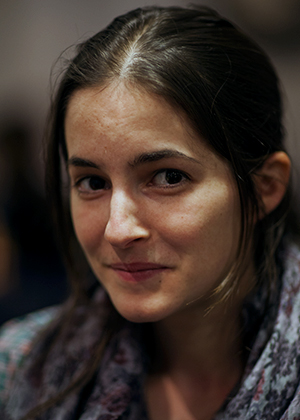
Information
Located in: Room 7.06, Malet Place Engineering Building, UCL
Supervised by:
Dr Kenny Mitchell, Disney Research Zurich
Research Information:
I am an EngD VEIV student at UCL under the joint supervision of Dr. Tim Weyrich (UCL) and Dr. Kenny Mitchell (DRZ). My project looks at creating tools for virtual environment design artists to improve fluidity of work flow.
Acquiring Procedural Environmental Models in The Wild
We aim to give artists better 3D references and scene reconstructions which can be directly fed into the creative pipeline. This is motivated by the increasing public demand for detailed, complex 3D worlds and the resulting demand this places on game design artists.
This project is looking at developing acquisition and modelling technologies that provide more than just a visual reference: in the context of this project, visual acquisition and reconstruction methods shall be developed that provide richer, three-dimensional references, and that ultimately yield scene reconstructions that can directly be fed into the content creation pipeline. The project will focus on natural environments (as opposed to urban scenes) and may combine multi-spectral imaging, wide-baseline stereo reconstruction and semantic scene analysis to obtain approximate procedural representations of natural scenes.
Past Work
As part of my MSc in Computer Graphics, Vision, and Imaging (CGVI) at UCL, I undertook a project on semantic scene analysis of natural scenes using 2D images (thesis available on request).
Publications
Guided Ecological Simulation For Artistic Editing
of Plant Distributions In Natural Scenes
JCGT 2015
Abstract
In this paper we present a novel approach to author vegetation cover of large natural scenes. Unlike stochastic scatter instancing tools for plant placement (such as multi-class blue noise generators), we use a simulation based on ecological processes to produce layouts of plant distributions. In contrast to previous work on ecosystem simulation, however, we propose a framework of global and local editing operators that can be used to interact directly with the live simulation. The result facilitates an artist-directed workflow with both spatiallyand temporally-varying control over the simulation’s output. We compare our result against random-scatter solutions, also employing such approaches as a seed to our algorithm. We demonstrate the versatility of our approach within an iterative authoring workflow, comparing to typical artistic methods.

Paper: PDF (pending)
Frequency-Based Creation and Editing of Virtual Terrain
CVMP 2014
Winner of Best Student Poster Award, CVMP 2014
Abstract
Authoring virtual terrains can be a challenging task. Procedural and stochastic methods for automated terrain generation produce plausible results but lack intuitive control of the terrain features, while data driven methods offer more creative control at the cost of a limited feature set, higher storage requirements and blending artefacts. Moreover, artists often prefer a workflow involving varied reference material such as photographs, concept art, elevation maps and satellite images, for the incorporation of which there is little support from commercial content-creation tools. We present a {sketch-based} toolset for asset-guided creation and intuitive editing of virtual terrains, allowing the manipulation of both elevation maps and 3D meshes, and exploiting a layer-based interface. We employ a frequency-band subdivision of elevation maps to allow using the appropriate editing tool for each level of detail. Using our system, we show that a user can start from various input types: storyboard sketches, photographs or height maps to easily develop and customise a virtual terrain.
Approximating Urban Wind Interference
SimAUD 2014
Winner of Best Student Paper Award, SIMAUD 2014 (link)
Abstract
A new approach is demonstrated to approximate computational fluid dynamics (CFD) in urban tall building design contexts with complex wind interference. This is achieved by training an artificial neural network (ANN) on local shape and fluid features to return surface pressure on test model meshes of complex forms. This is as opposed to the use of global model parameters and Interference Factors (IF) commonly found in previous work. The ANN is trained using shape and fluid features extracted from a set of evaluated principal (design) models (PMs). The regression function is then used to predict results based on shape features from the PM and fluid features from a one-off obstruction model (OM), context only, simulation. For the application of early-stage generative design, the errors (against CFD validation) are less than 10% centred standard deviation σ, whilst the front-end prediction times for the test cases are around 20s (up to 500 times faster than the CFD).

Paper: PDF
Multi-Spectral Material Classification in Landscape Scenes Using Commodity Hardware
CAIP 2013
Abstract
We investigate the advantages of a stereo, multi-spectral acquisition system for material classi cation in ground-level landscape images. Our novel system allows us to acquire high-resolution, multi-spectral stereo pairs using commodity photographic equipment. Given additional spectral information we obtain better classiffcation of vegetation classes than the standard RGB case. We test the system in two modes: splitting the visible spectrum into six bands; and extending the recorded spectrum to near infra-red. Our six-band design is more practical than standard multi-spectral techniques and foliage classiffcation using acquired images compares favourably to simply using a standard camera.
Multi-Spectral Material Classification in Landscape Scenes Using Commodity Hardware
ICCP 2013
Abstract
We investigate the advantages of a stereo, multi-spectral acquisition system for material classi cation in landscape scenes. To obtain additional bands of spectral information, and to ensure a high spatial resolution, we use commodity hardware to create a stereo, multi-spectral capture system. Whilst alternative systems are either slow or impractical when considering ground-level image acquisition, our resulting system allows for fast, simple, hand-held multi-spectral image acquisition. We show that foliage classi cation using images acquired with our 6-band design compares favourably to simply using a standard RGB camera.
Stereo reconstruction Under a Light Budget
CVMP 2012
Abstract
Image-pairs captured from a rig of two, carefully arranged cameras are increasingly used to reconstruct partial 3D information. A crucial step in this reconstruction is the matching of points in the two images that are projections of the same 3D point through each camera. Despite receiving much attention, algorithms to match correspondencing points in two-frame stereo images are both slow, as well as surprisingly fragile. The problem is exacerbated by noise or blur in the input images because of the potential ambiguities they introduce in the matching process.
For scenes that are poorly illuminated, it is necessary to make a combination of three adjustments: To increase the size of the aperture to allow more light; to increase the duration of exposure; and to increase the sensor-gain (ISO). These adjustments potentially introduce defocus, motion blur and noise - all of which adversely affect reconstruction. We present an exploratory study of how they relatively affect stereo-correspondence algorithms by comparing the accuracy and precision of three reconstruction algorithms over the space of exposures.
VEIV: Celebrating the Engineering Doctorate in Virtual Environments, Imaging & Visualisation at University College London
Synopsis
"This volume celebrates over a decade of outstanding research and academic achievement. The portfolio of current and complete projects is a legacy to VEIV’s position at the forefront of collaborative research in graphics, interactions and complex design. VEIV now looks ahead to furthering the advancement and innovation of visual and interactive technologies."

Book: PDF, 17MB
MSc Computer Graphics, Vision, and Imaging, UCL - 2009-2010
I completed my Masters in Computer Graphics, Vision and Imaging in September 2010, having looked at material classification in outdoor scenes as the topic of my dissertation.
An overview of results can be found here and the dissertation can also be downloaded .
MRes Virtual Environments, Imaging, and Visualisation Projects - 2010-2011
The first year of the EngD VEIV program involves several projects, aiming both for inter-disciplinary collaboration as well as a solid start to personal research. My current projects are:
This involves looking at different means of scene reconstruction with particular application to natural environments and is as much a programming exercise as a research initiative.
This project will apply Machine Learning Techniques to computational fluid dynamics models with the aim of creating a system capable of predicting turbulence around a structure and optimising the structure to reduce this turbulence.
I have also taken courses in Supervised Learning and Graphical Models.





